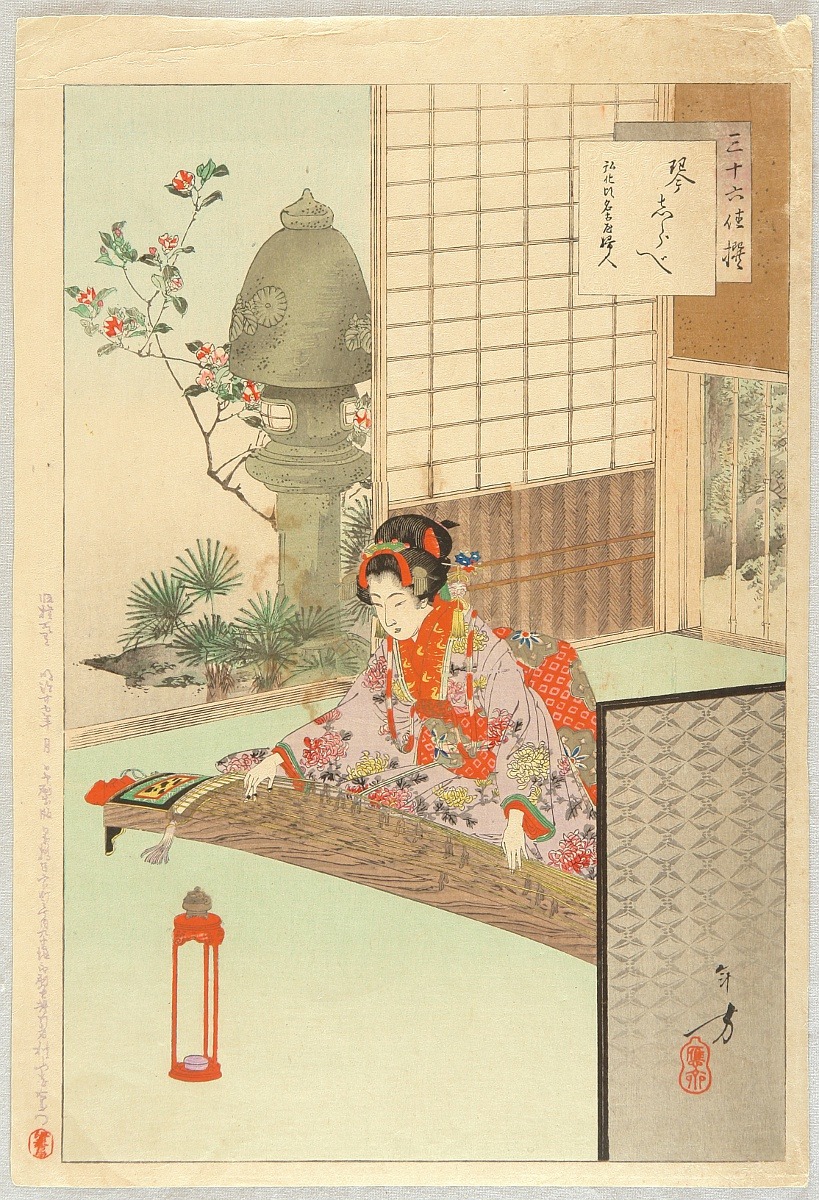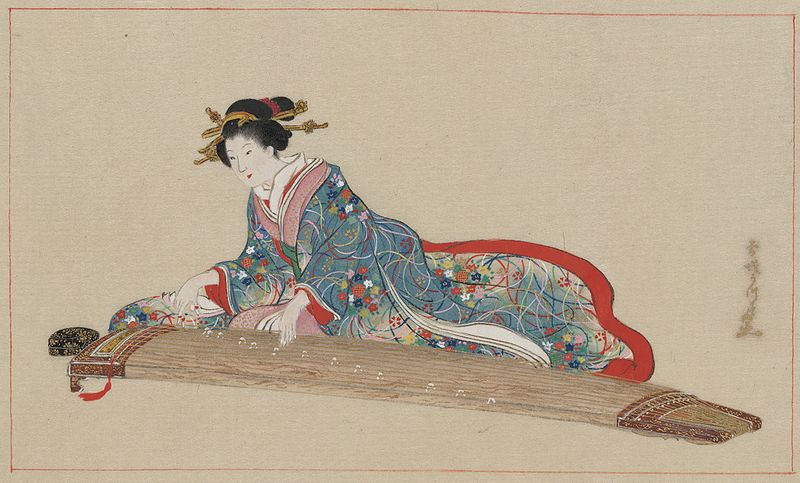 Chikanobu Toyohara (1838-1912), Koto Player – Azuma
Chikanobu Toyohara (1838-1912), Koto Player – Azuma
David Bowie’s instrumental piece “Moss Garden”, the second of the three instrumentals on side two of album “Heroes” released in 1977, is a serene, tranquil oasis of light in the desert of darkness which makes the majority of the album’s sound. Situated between the fellow two instrumentals, dark and foreboding “Sense of Doubt” and equally grim “Neuköln”, the “Moss Garden”, strange and serene, is like a ray of sun on a moody, cloudy spring day that appears for a moment and disappears quickly behind the clouds. Bowie plays the traditional Japanese string instrument koto on the track and Brian Eno plays the synthesizer. “Moss Garden” is a delightful five minutes and three seconds of lightness and meditative, ambient ethereal sounds. So, one cannot refer to “Heroes” as to a dark album, why, one eighth of the album is uplifting. And then there’s the song “Heroes” as well.
It’s been quite some time since I discovered Bowie’s Berlin era songs, but this song lingered in my memory, and I think the reason for that is the eastern sound of the koto. I mean, how many rock songs are coloured by far-east sounds like that? Listening to this instrumental piece made me think of all the Ukiyo-e prints where beautiful Japanese ladies dressed in vibrant clothes are playing koto and I found a few lovely examples which I am sharing in this post. A lot of these Japanese woodcut prints (or Ukiyo-e prints) were made by Chikanobu, an artist who worked mostly in the 1880s and 1890s, the last fruitful decades for the art of woodcuts and in his work he mostly focused on beautiful women doing everyday things. I really enjoy the elegant simplicity of the woodcut above; how the background is clear but the lady’s purple kimono stands out and the focus is solely on her and her koto; back to bare essentials. I also really love Hasegawa Settei’s portrayal of lady playing kimono.

Toyohara Chikanobu, Preparing to Play the Koto, from the series Ladies of the Tokugawa Period, 1895

Toshikata Mizuno (1866-1914), Thirty-six Selected Beauties – Playing Koto

Hasegawa Settei, A Japanese woman playing the koto, December 1878

Toyohara Chikanobu (1838-1912), Playing Koto, c 1890s

Toyohara Chikanobu (1838-1912), Koto Player at 11 a.m. – Scenes of the Twenty-four Hours, c 1890s
Moss gardens are a special variety of Japanese gardens, the continuous flow of unending moss coated ground lets the person slowly fall into the dreamy and meditative state, and allows the eye to wander from one variety of moss to the other, the nostrils to inhale the rich, green, primeval scent of this old and grateful plant. I imagine it rich with water after a rainy summer afternoon. “A moss garden presents the opportunity to observe differentiations of colour that have never been seen before. The tactile and optical characteristics of the moss gardens are softness, sponginess, submarine wateriness and unfathomability. They are the exact opposite of the pebble gardens with their appointed paths, boundaries and stone islands.” (Siegfried Wichmann; Japonism)
When life gets overwhelming, one can sit for hours in such a garden and easily sink into a meditative state, thoughts drifting and problems fading. In a similar way, Bowie’s move to Berlin with Iggy Pop in 1976 was his way of finding clarity, anonymity and inspiration: “I had approached the brink of drug induced calamity one too many times and it was essential to take some kind of positive action. For many years Berlin had appealed to me as a sort of sanctuary like situation. It was one of the few cities where I could move around in virtual anonymity.“(Bowie with Rob Hughes and Stephen Dalton for Uncut Magazine) After the very depressing album “Low” released earlier the same year, 1977, album “Heroes” is the first step in the path of Bowie’s search for clarity and perhaps the song “Moss Garden” is the best expression of this new found quite, introspective feeling of serenity.

Keiko Yurimoto (1906-2000), Koto Player, c 1950
Berlin in the seventies was a grey, isolated and divided city with a world-weary self-regard. The youth suffered and junkies filled the subway stations, but a lot of bohemians, artists and musicians were drawn to that bleak, alienated and experimental atmosphere and relished in what the city had to offer. As Bowie said himself: “For many years Berlin had appealed to me as a sort of sanctuary-like situation. It was one of the few cities where I could move around in virtual anonymity. I was going broke; it was cheap to live. For some reason, Berliners just didn’t care. Well, not about an English rock singer, anyway.” He was just another weirdo in the city and everyone left him alone. The product of his fascination with the city were three albums; Low, Heroes and Lodger – today known as Bowie’s “Berlin Trilogy”, by far my favourite era of Bowie’s music. Bowie said himself about the Berlin Trilogy: “My complete being is within those three albums.” (Uncut magazine) Enough said. I don’t really understand or share the wild enthusiasm for Bowie’s glam rock Ziggy Stardust era, I mean those are some great songs, but the Berlin era is the real thing, it sounds as if the mood of the times and the city with its bleakness and political division is woven into the music, to me it sounds like Berlin breathing and living.


